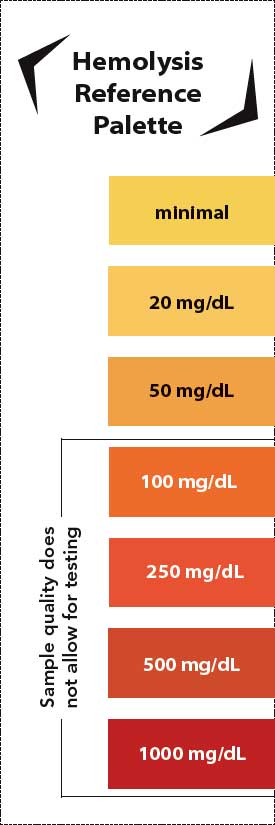A Quick-Reference Tool for Hemolysis Status
Print-only version [PDF – 2 pages]Hemolysis is the breakdown of red blood cells, which can have an effect on laboratory results. Serum samples containing more than 100 mg/dL of hemoglobin can cause non-specific binding in serologic tests. Therefore, serologic testing is not recommended for a serum sample containing more than this amount of hemoglobin.
Knowing the hemolysis status of a serum sample before testing can save time and resources. CDC’s Division of Vector-Borne Diseases created a quick-reference “Hemolysis Reference Palette” for laboratorians and phlebotomists to use when the hemolysis status of a sample is in question.
Create a Hemolysis Reference Palette
- Print the palette from a color printer. Be sure to mark “Print on Both Sides.”
- Cut out the palette with scissors by cutting along the dotted line.
- Laminate the palette.
- Place palette(s) around the laboratory for easy access:
- Glue a magnet on the back, or
- Punch a hole at the top and hang from a hook.
How to Use the Palette
- Place serum sample on a white background.
- Compare color tabs on the palette to the serum sample.
- Determine the sample quality using the color referenced on the palette.
- Serum samples that match colors with 100 mg/dL or darker should not be processed by serology testing.
Prevention of hemolysis is important to preserve the quality of a serum sample for testing.
Best Practices to Prevent Hemolysis
- Use the correct needle size for blood collection (20-22 gauge).
- Avoid using butterfly needles, unless specifically requested by patient.
- Warm up the venipuncture site to increase blood flow.
- Allow disinfectant on venipuncture site to dry completely.
- Collect blood sample in the correct blood collection tube (red cap/tiger tube = without anticoagulants).
- Collect the correct volume for the tube size. Use smaller tubes for difficult draws.
- Coagulation: place the tube in an upright position for 15-30 minutes at room temperature. Then store at 4°C.
- Centrifuge samples for serum separation within 4 hours of sample collection.
- If tests are performed within 48 hours of collection, transfer serum to a sample tube (cryovial) and store at 4°C.
- If tests will be performed more than 48 hours after collection, aliquot samples and store at -20°C or lower.
In the Field: Forensic Scientists Use Hemolysis Reference Palette in Crime Lab
Forensic scientists at the Scottsdale Police Department Crime Laboratory used the Hemolysis Reference Palette for hemolysis status to study the effects of blood hemolysis on forensic blood ethanol testing. They used the reference palette to qualitatively gauge the degree of hemolysis with their test samples. Learn more about this interesting application in the Journal of Forensic Sciences (Kosecki PA, et al. The effect of sample hemolysis on blood ethanol analysis using headspace gas chromatography. J Forensic Sci. 2021;00:1-7).
